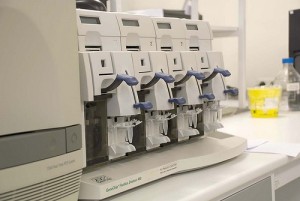RMIT University researchers have successfully developed the first liquid metal enabled pump that will allow micro-fluidics and lab-on-a-chip technology to finally realise their potential, with applications ranging from biomedicine to biofuels.

Image credit: flickr User: Progenika
According to the media release by RMIT University, the pump uses droplets of Galinstan – a non-toxic liquid metal alloy comprised of gallium, indium and tin – as the core of a pumping system to induce flows of liquid in looped channels.
The alloy is activated by applying voltage, which causes the charge distribution along the surface to be altered. This propels the surrounding liquid without moving the Galinstan droplet through the loop, using a process called “continuous electrowetting”.
Dr Khashayar Khoshmanesh, the lead investigator and a Research Fellow in the Centre for Advanced Electronics and Sensors at RMIT, said there was no easy way to drive liquid around a fluidic chip in micro-fabricated systems.
“Lab-on-a-chip systems hold great promise for applications such as biosensing and blood analysis but they currently rely on cumbersome, large-scale external pumps, which significantly limit design possibilities,” he said.
“Our unique pump enabled by a single droplet of liquid metal can be easily integrated into a micro device, has no mechanical parts and is both energy efficient and easy to produce or replace.”
According to him, integrated micro-fluids hold great potential to revolutionize the way we process chemicals and manipulate bio-practices at the micro scale, much similar to the way integrated micro-electronics have revolutionised the way that we process information – enabling the development of computers and smart phones.
“This innovation shows that micro- and nano-scale pumping can be accomplished with a simple system – a crucial advance for the field of micro-fluidics,” added Mr Khoshmanesh.
The pump is highly controllable, and one can adjust the flow rate simply by altering the frequency, magnitude and waveform of the applied signal. The flow direction can also be reversed by reversing the polarity of the applied voltage.




















